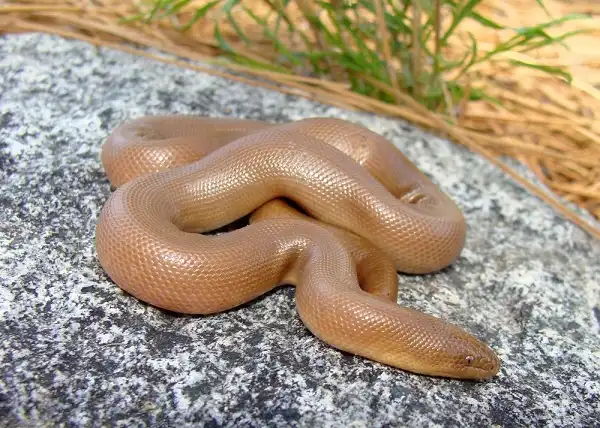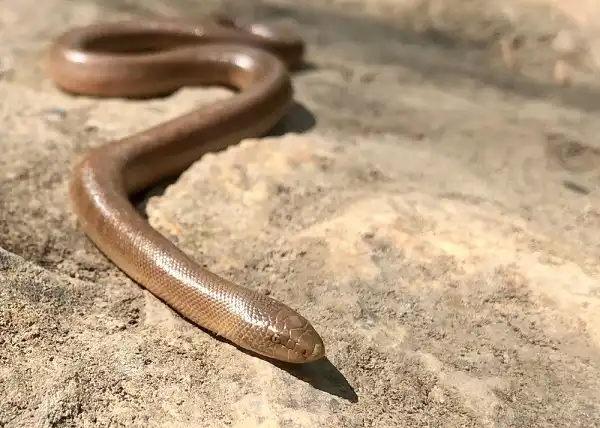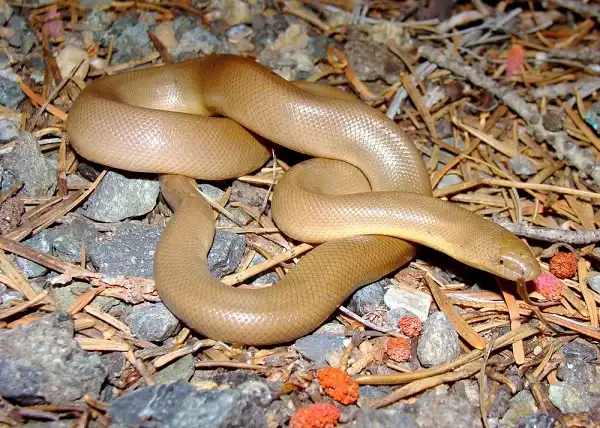Are you looking for an exotic pet to make your home feel like a tropical paradise? The Rubber Boa could be the perfect companion for you! These snakes are native to western North America, and they are gentle yet cute reptiles with unique characteristics. Unlike other snakes, the Rubber Boa is slow-moving and docile, so it can easily adapt to its new environment while avoiding any unwanted adventures. It even has special features that distinguish it from other species – aside from just being abnormally huggable. Read on to learn more about this intriguing serpent!

Rubber Boa Description
Rubber Boas, also known as Charina bottae, are non-venomous snakes that are found in western North America. They are notable for their smooth, rubbery skin, which feels, unlike other snakes. Rubber boas have a unique physical characteristic that sets them apart from other snakes – they have a prehensile tail. This means that they can grasp onto branches or other objects, which allows them to climb and navigate their environment more easily. Additionally, rubber boas have blunt noses and small eyes that are set high on their head. Their coloring can vary from a rusty brown to an almost black shade, with a creamy-yellow underside.
Rubber Boa Habitat
Rubber boas are primarily found in forested regions with high moisture levels, such as the Pacific Northwest. They prefer areas with dense undergrowth and plentiful vegetation, as well as rocky outcroppings or downed logs where they can hide when necessary. While rubber boas are not picky about their surroundings, they do require a certain level of security and are naturally shy creatures. Therefore, a secure enclosure with ample hiding places is necessary when keeping them in captivity. They also require relatively low levels of light and heat, as they are typically nocturnal and don’t require basking spots. Since rubber boas are primarily burrowers, they also require a substrate that allows for easy digging. Aspen shavings or coconut fiber are excellent options for their bedding. It’s crucial to avoid any hard or sharp edges in their enclosure, as this could potentially cause injury to their rubbery skin.
Rubber Boa Diet
Rubber boas, being small snakes, primarily feed on small rodents, such as voles and mice. In the wild, they are opportunistic predators and may occasionally supplement their diet with lizards, smaller snakes, or insects. In captivity, their diet can be easily maintained with frozen and thawed mice or small rats. It’s crucial to ensure that the prey item is appropriately sized for the snake, as feeding a rubber boa too large of a meal can cause digestive problems. A good rule of thumb is to ensure that the prey item is no larger than the girth of the snake. Rubber boas are known to be slow eaters and may take up to several hours to consume a meal fully. Therefore, it’s essential to avoid handling them immediately after feeding, as this can stress the snake and potentially cause regurgitation.

Rubber Boa Size
Rubber boas are a relatively small species of snake, with adults typically reaching a length of 14-20 inches. However, some individuals have been known to grow to lengths of up to 30 inches. They are also relatively thick-bodied, with males typically being thinner than females. As with many snake species, female rubber boas are typically larger than males. They also tend to have larger heads and thicker tails, which are important for reproduction. Rubber boas are known to have a slow growth rate, taking several years to reach full size. In addition to their size and distinctive skin texture, rubber boas are also recognizable by their coloration. They typically have a light brown or tan body with darker blotches, although some individuals may be more reddish or gray in color. One interesting feature of their coloration is that it can vary depending on the temperature and amount of sunlight they are exposed to, with individuals becoming darker in cooler temperatures.
Rubber Boa Lifespan
Rubber boas are known for their longevity in captivity, with individuals kept in appropriate conditions living up to 25 years. In the wild, their lifespan is believed to be shorter due to predation and other environmental factors. One of the keys to ensuring a long, healthy life for a rubber boa is providing them with a suitable environment. They require a habitat with a moderate temperature range, typically between 70-85°F, and relative humidity of around 50-60%. Additionally, they benefit from a hiding spot and a substrate that mimics their natural environment, such as aspen shavings or reptile bark. With proper care and attention, rubber boas can live long, healthy lives in captivity. They are fascinating and unique snakes with many unusual physical characteristics, making them an appealing choice for reptile enthusiasts looking for something a little different. However, it’s important to remember that any pet snake requires a significant commitment and responsibility, so it’s essential to do research and seek advice from experienced keepers before making a decision to bring one into your home.
Rubber Boa Behavior
Rubber boas, despite being small in size and not considered an aggressive species, are known for their fascinating behavior. They are primarily nocturnal and spend much of their time hiding under rocks, logs, or underground burrows during the day. Rubber boas are also known for their unique defense mechanism. When confronted with danger, they curl up into a ball and tuck their heads under their coils, resembling a rubber ball. Additionally, their skin is incredibly elastic, allowing them to stretch and twist their bodies in unexpected ways to escape predators. One unique aspect of rubber boa behavior is its social nature. They have been observed sharing underground burrows with other snakes and even different species. It is thought that this behavior may be a way to conserve heat and reduce energy expenditure in cold environments. Overall, rubber boas are fascinating snakes with unique physical characteristics and interesting behaviors. Their docile nature, longevity, and adaptability to captivity make them a popular choice as a pet.

Rubber Boa Speed
Rubber boas are not known for their speed; in fact, they are one of the slowest-moving snake species. They often rely on camouflage and their unique defensive balling technique to avoid predators. Rubber boas can travel at a maximum speed of only 0.7 mph (1 km/h). This makes them much slower than other members of the Colubridae family, such as garter snakes, which can reach speeds up to 3 mph (5 km/h). However, rubber boas do have impressive agility and maneuverability. When confronted with danger, they are capable of wriggling and twisting their bodies into tight spaces or under debris for protection. Additionally, despite their small size, they have powerful muscles and are capable climbers, able to move up vertical surfaces with ease.
Rubber Boa Hunting
Rubber boas are fascinating creatures with unique physical characteristics and interesting behaviors. Despite their slow and docile nature, they are skilled hunters with a range of techniques and adaptations that make them successful in the wild. Rubber boas primarily hunt at night, using their keen sense of smell to track down their prey. They have been known to track prey over long distances and can locate food even when it is hidden from sight. Once they have located their prey, rubber boas will use their powerful muscles to constrict their prey, suffocating it before consuming it whole. Their diet mainly consists of small mammals, lizards, and insects, which they hunt using a variety of techniques.
For example, they may employ a sit-and-wait approach, lying in wait for their prey to come to them. Alternatively, they may actively search for food, using their excellent climbing skills to hunt for prey in trees or other high locations. Rubber boas have also developed a unique defense mechanism that helps them to avoid predators. When threatened, they will curl up into a ball and tuck their head under their coils, resembling a rubber ball. This behavior can make them difficult to handle and may impact their speed, as they are not able to move as freely in this position.
Rubber Boa Health Issues and Care
Like all pet snakes, rubber boas require a suitable environmental setup and a balanced diet to remain healthy. This includes providing them with an enclosure that is large enough for them to move around in, as well as the correct temperature and humidity levels. They should also be fed regularly with mice or other small prey appropriate for their size. In addition, regular checkups with a veterinarian are advised to ensure that your rubber boa remains healthy and free from any health issues. Common health problems that may affect rubber boas include soft shell syndrome, respiratory infections, and mites – all of which can usually be treated successfully if caught early on.

Conclusion
Rubber boas are fascinating creatures with unique physical characteristics and interesting behaviors. They possess a range of adaptations that give them an advantage as hunters, enabling them to track down prey over long distances and employ a variety of techniques to capture it. As pets, they require proper care and attention, including a suitable environment, a balanced diet, and regular veterinary checkups. By providing rubber boas with the care they need, owners can ensure that their pet snakes live happy and healthy lives as fascinating members of the animal kingdom. Not only do rubber boas make great pets due to their docile nature and longevity, but they also offer owners the opportunity to observe their hunting skills in action – making for an unforgettable experience.
Frequently Asked Question


